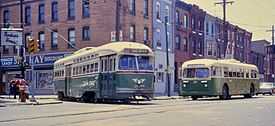Philadelphia Transportation Company
|
| |
| Overview | |
|---|---|
| Locale | Philadelphia, Pennsylvania, U.S. |
| Transit type | |
| Headquarters |
200 W. Wyoming Avenue,[1] Philadelphia, Pennsylvania |
| Operation | |
| Began operation | 1940 |
| Ended operation | 1968 (taken over by SEPTA) |
| Technical | |
| Track gauge |
4 ft 8 1⁄2 in (1,435 mm) (rapid transit lines) 5 ft 2 1⁄4 in (1,581 mm) (trolley/streetcar lines) |
_Bridge_Line_%26_Fare_Tokens.jpg)
The Philadelphia Transportation Company (PTC) was the main public transit operator in Philadelphia, Pennsylvania, from 1940 to 1968.
A private company, PTC was the successor to the Philadelphia Rapid Transit Company (PRT), in operation since 1902, and was the immediate predecessor of the Southeastern Pennsylvania Transportation Authority (SEPTA).[2]
History
PTC was established on January 1, 1940, by the merger of the PRT and several smaller, then-independent transit companies operating in and near the city. It operated a city-wide system of bus, trolley, and trackless trolley routes, the Market–Frankford Line (subway-elevated rail), the Broad Street Line (subway), and the Delaware River Bridge Line (subway-elevated rail to City Hall, Camden, New Jersey, and now part of the PATCO Speedline) which became SEPTA's City Transit Division. Most suburban transit lines were operated by other private companies, such as the Philadelphia Suburban Transit Company, rather than by PTC.
Among PTC's first actions was to begin modernizing the aging vehicle fleet. In 1940, the company placed orders for 130 PCC streetcars, 50 trackless trolleys, and 53 motor buses.[3] Although the rapid transit lines in urban Philadelphia – principally the Market–Frankford Line and Broad Street Line – were operated by PTC, their fixed infrastructure was owned by the City of Philadelphia and leased to PTC.
In 1955,[4] majority control of PTC was acquired by the National City Lines holding company, which had a reputation for favoring buses and abandoning trolley lines in other cities.[2][3] In 1954, the PTC trolley system included 45 lines, using more than 1,500 trolley cars.[4] Between 1954 and 1958 alone, three-fourths of the trolley lines were abandoned, and 984 trolley cars had been scrapped, replaced by 1,000 new buses.[3] PTC's network also included the Philadelphia trolleybus (trackless trolley) system, which was much smaller,[5] along with numerous bus lines.
The Southeastern Pennsylvania Transportation Authority (SEPTA) was established in 1964, as part of efforts by the Pennsylvania legislature to coordinate government subsidies to various transit and railroad companies in southeastern Pennsylvania. The provision of public transit service was becoming increasingly unprofitable in the 1950s and 1960s,[2] and cities across the country were municipalizing their transit systems or creating regional public transit authorities. SEPTA acquired the Philadelphia Transportation Company in 1968, taking possession of PTC at noon on September 30, 1968.[6] The total price paid to PTC stockholders for the purchase was $47.9 million[1] (equivalent to $325 million in 2015[7]).
See also
References
- ↑ 1.0 1.1 Meyer, Eugene L. (September 29, 1968). "SEPTA to Take Over PTC Tomorrow, To Cap Five Years of Negotiations". The Sunday Bulletin (Philadelphia, Pennsylvania). Section 1, p. 8. Retrieved 2014-08-07.
- ↑ 2.0 2.1 2.2 Hepp, John. Public Transportation. 2013. The Encyclopedia of Greater Philadelphia. Rutgers University. Retrieved 2014-08-07.
- ↑ 3.0 3.1 3.2 Schneider, Fred W.; Carlson, Stephen P. (1983). PCC From Coast to Coast. (Glendale, California): Interurban Press. pp. 140–146. ISBN 0-916374-57-2.
- ↑ 4.0 4.1 Springirth, Kenneth C. (2008). Southeastern Pennsylvania Trolleys. Arcadia Publishing. pp. 10–11. ISBN 978-0-7385-5692-5.
- ↑ Sebree, Mac; Ward, Paul (1974). The Trolley Coach in North America. Los Angeles: Interurbans. pp. 209–212. LCCN 74020367.
- ↑ "Where Were You When SEPTA Took Control of P.T.C.?". SEPTA. Retrieved 2014-08-07.
- ↑ Consumer Price Index (estimate) 1800–2014. Federal Reserve Bank of Minneapolis. Retrieved February 27, 2014.
